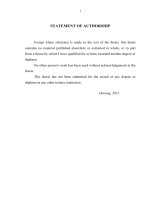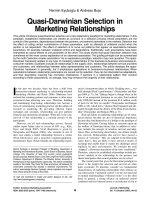lectures in marketing
Bạn đang xem bản rút gọn của tài liệu. Xem và tải ngay bản đầy đủ của tài liệu tại đây (2.51 MB, 286 trang )
Lectures in Marketing
Prepared by:
Dr.Mayar Farrag El-Sayed
Dr.Mayar Farrag Elsayed
Page 1
Part 1.Understanding marketing:
Chapter 1: Marketing in a changing world: creating customer
satisfaction.
Chapter 2: strategic planning and the market process.
Chapter 3: The global marketing environment.
Chapter 1:
Dr.Mayar Farrag Elsayed
Page 2
Marketing in a changing world: creating customer
satisfaction.
Chapter Overview
In this chapter, we introduce the basic concepts of marketing. It
starts with the question, “What is marketing?” Simply put,
marketing is managing profitable customer relationships. The aim
of marketing is to create value for customers and to capture value
from customers in return. Next is discussed the five steps in the
marketing process – from understanding customer needs, to
designing customer-driven marketing strategies and programs, to
building customer relationships and capturing value for the firm.
Finally is discussed the major trends and forces affecting
marketing in this age of customer relationships.
Marketing is the delivery of customer satisfaction at a profit.
The goal of marketing is to attract new customers by promising
superior value, and to keep current customers by delivering
satisfaction.
Some people think that only large business organizations
operating in highly developed economies use marketing, but
Dr.Mayar Farrag Elsayed
Page 3
sound marketing
is
critical to
the success
of every
organization—whether large or small, for-profit or nonprofit,
domestic or global.
Large for-profit firms such as Coca-Cola, McDonald's, Sony,
IBM, General Electric, Federal Express, Wal-Mart, and Marriott
use marketing. But so do nonprofit organizations such as
colleges, hospitals, museums.
What is marketing?
What does the term marketing mean? Many people think of
marketing only as selling and advertising. And no wonder—
every day we are bombarded with television commercials,
newspaper ads, direct mail, and sales calls. Someone is always
trying to sell us something.
Therefore, you may be surprised to learn that selling and
advertising is only the tip of the marketing iceberg. Although
they are important, they are only two of many marketing
functions, and often not the most important ones.
Dr.Mayar Farrag Elsayed
Page 4
Today, marketing must be understood not in the old sense of
making a sale—"telling and selling"—but in the new sense of
satisfying customer needs.
If the marketer does a good job of understanding consumer
needs; develops products that provide superior value; and prices,
distributes, and promotes them effectively, these products will
sell very easily.
Marketing
A social and managerial process by which individuals and
groups obtain what they need and want through creating and
exchanging products and value with others.
We define marketing as a social and managerial process by
which individuals and groups obtain what they need and want
through creating and exchanging products and value with
others.
To explain this definition, we examine the following important
terms: needs, wants, and demands; products; value, satisfaction,
and quality; exchange, transactions, and relationships; and
markets.
Dr.Mayar Farrag Elsayed
Page 5
Figure 1-1 shows that these core marketing concepts are linked,
with each concept building on the one before it.
NEEDS , WANTS , AND DEMANDS
The most basic concept underlying marketing is that of human
needs. Human needs are states of felt deprivation. Humans
have many complex needs.
Dr.Mayar Farrag Elsayed
Page 6
These include basic physical needs for food, clothing, warmth,
and safety; social needs for belonging and affection; and
individual needs for knowledge and self-expression. These needs
are not invented by marketers; they are a basic part of the human
makeup. When a need is not satisfied, a person will try either
to reduce the need or look for an object that will satisfy it.
Wants are the form taken by human needs as they are shaped by
culture and individual personality. A hungry person in Egypt
may want a fool or falafel sandwich.
Wants are described in terms of objects that will satisfy needs.
As a society evolves, the wants of its members expand. As
people are exposed to more objects that arouse their interest and
desire, producers try to provide more want-satisfying products
and services.
People have almost unlimited wants but limited resources.
Thus, they want to choose products that provide the most value
and satisfaction for their money.
When backed by buying power, wants become demands.
Dr.Mayar Farrag Elsayed
Page 7
Consumers view products as bundles of benefits and
choose products that give them the best bundle for their
money.
Thus, a Fiat Car means basic transportation, low price,
and fuel economy. A Mercedes means comfort, luxury,
and status.
Given their wants and resources, people demand products
with the benefits that add up to the most satisfaction.
Outstanding marketing companies go to great lengths to learn
about and understand their customers' needs, wants, and
demands.
They conduct consumer research, focus groups, and customer
clinics. They analyze customer complaint, inquiry, warranty,
and service data. They train salespeople to be on the lookout
for unfulfilled customer needs. They observe customers using
their own and competing products, and interview them in depth
about their likes and dislikes.
In these outstanding companies, people at all levels—including
top management—stay close to customers in an ongoing effort
to understand their needs and wants.
Dr.Mayar Farrag Elsayed
Page 8
For example, top executives from Wal-Mart spend two days
each week visiting stores and mingling with customers. At
Motorola, in addition to surveying customers about their quality
needs, analyzing customer complaints, and studying customer
service records, top executives routinely visit customers at their
offices to gain better insights into their needs.
PRODUCTS
People satisfy their needs and wants with products. A product is
anything that can be offered to a market to satisfy a need or
want. Usually, the word product suggests a physical object,
such as a car, a television set, or a bar of soap.
However, the concept of product is not limited to physical
objects—anything capable of satisfying a need can be called a
Dr.Mayar Farrag Elsayed
Page 9
product. The importance of physical goods lies not so much in
owning them as in the benefits they provide.
Marketers often use the expressions goods and services to
distinguish between physical products and intangible ones.
Moreover, consumers obtain benefits through other vehicles,
such as persons, places, organizations, activities, and ideas.
Many sellers make the mistake of paying more attention to the
physical products they offer than to the benefits produced by
these products. They see themselves as selling a product rather
than providing a solution to a need.
VALUE , SATISFACTION , AND QUALITY
Consumers usually face a broad array of products and services
that might satisfy a given need. How do they choose among
these many products and services?
Consumers make buying choices based on their perceptions of
the value that various products and services deliver.
Dr.Mayar Farrag Elsayed
Page 10
Customer value is the difference between the values the customer
gains from owning and using a product and the costs of
obtaining the product. For example, Federal Express customers
gain a number of benefits. The most obvious are fast and
reliable package delivery.
Customer satisfaction The extent to which a product's perceived
performance matches a buyer's expectations. If the product's
performance falls short of expectations, the buyer is dissatisfied.
If performance matches or exceeds expectations, the buyer is
satisfied or delighted.
Customer satisfaction depends on a product's perceived
performance in delivering
value
relative
to
a
buyer's
expectations.
If the product's performance falls short of the customer's
expectations, the buyer is dissatisfied. If performance matches
expectations, the buyer is satisfied. If performance exceeds
expectations, the buyer is delighted.
Satisfied customers make repeat purchases, and they tell others
about their good experiences with the product.
Dr.Mayar Farrag Elsayed
Page 11
The key is to match customer expectations with company
performance. Smart companies aim to delight customers by
promising only what they can deliver, then delivering more than
they promise.
Customer satisfaction is closely linked to quality. In recent years,
many companies have adopted total quality management (TQM)
programs, designed to constantly improve the quality of their
products, services, and marketing processes. Quality has a direct
impact on product performance, and hence on customer satisfaction.
Quality begins with customer needs and ends with customer
satisfaction.
EXCHANGE, TRANSACTIONS, AND RELATIONSHIPS
Marketing occurs when people decide to satisfy needs and
wants through exchange. Exchange is the act of obtaining a
desired object from someone by offering something in return.
Exchange is only one of many ways people can obtain a desired
object. For example, hungry people can find food by hunting,
fishing, or gathering fruit.
Dr.Mayar Farrag Elsayed
Page 12
For an exchange to take place, several conditions must be
satisfied. Of course, at least two parties must participate, and
each must have something of value to the other. Each party also
must want to deal with the other party and each must be free to
accept or reject the other's offer. Finally, each party must be
able to communicate and deliver.
In this sense, exchange creates value just as production creates
value. It gives people more consumption possibilities.
Whereas exchange is the core concept of marketing, a
transaction is marketing's unit of measurement.
A transaction consists of a trade of values between two parties.
In a transaction, we must be able to say that one party gives
X to another party and gets Y in return.
Transaction marketing is part of the larger idea of relationship
marketing. Beyond creating short-term transactions, marketers
need to build long-term relationships with valued customers,
distributors, dealers, and suppliers.
Dr.Mayar Farrag Elsayed
Page 13
Increasingly, marketing is shifting from trying to maximize the
profit on each individual transaction to maximizing mutually
beneficial relationships with consumers and other parties.
The operating assumption is: Build good relationships and
profitable transactions will follow.
MARKETS
The concept of exchange leads to the concept of a market. A
market is the set of actual and potential buyers of a product.
These buyers share a particular need or want that can be
satisfied through exchange.
The Size of a market depends on the number of people who
exhibit the need, have resources to engage in exchange, and are
willing to offer these resources in exchange for what they
want.
Originally the term market stood for the place where buyers and
sellers gathered to exchange their goods.
Dr.Mayar Farrag Elsayed
Page 14
Marketers see the sellers as constituting an industry and the
buyers as constituting a market. The sellers send products,
services, and communications to the market; in return, they
receive money and information.
MARKETING
MANAGEMENT
PHILOSOPHIES
Marketing
carrying
management
out
exchanges
tasks
with
to
target
is
described
achieve
as
desired
markets.
What
philosophy should guide these marketing
efforts?
There are five alternative concepts under which
organizations
conduct
their
marketing
activities: the production, product, selling,
marketing, and societal marketing concepts.
THE PRODUCTION CONCEPT
Dr.Mayar Farrag Elsayed
Page 15
The production concept holds that consumers
will favor products that are available and
highly affordable and that management should
therefore focus on improving production and
distribution efficiency.
This concept is one of the oldest philosophies
that guide sellers. The production concept is
still a useful philosophy in two types of
situation:
The first occurs when demand for product
exceeds the supply. Here, management should
look to ways to increase production.
The second situation occurs when the product's
cost is too high and improved productivity is
needed to bring it down.
For example, Henry Ford's whole philosophy
was to perfect the production of the Model T
so that its cost could be reduced and more
people could afford it.
Dr.Mayar Farrag Elsayed
Page 16
However,
companies
operating
under
a
production philosophy run a major risk of
focusing too narrowly on their own operations.
They might focus on lowering cost to deliver
low prices and neglect design.
THE PRODUCT CONCEPT
The production concept holds that consumers
will favor products that offer the most quality,
performance, and features and that the
organization should therefore devote its
energy
to
making
continuous
product
improvements.
THE SELLING CONCEPT
Many organizations follow the selling concept,
which holds that consumers will not buy
enough of the organization's products unless it
Dr.Mayar Farrag Elsayed
Page 17
undertakes a large-scale selling and promotion
effort.
The concept
is
typically practiced
with
unsought goods—those that buyers do not
normally think of buying, such as encyclopedias
or insurance. These industries must be good at
tracking down prospects and selling them on
product benefits.
The selling concept also is practiced in the
nonprofit area. A political party, for example,
will vigorously sell its candidate to voters as a
fantastic person for the job.
Most firms practice the selling concept when
they have overcapacity.
Their aim is to sell what they make rather
than make what the market wants. Thus,
Dr.Mayar Farrag Elsayed
Page 18
marketing based on hard selling carries high
risks.
It focuses on creating sales transactions
rather than on building long-term, profitable
relationships with customers.
THE MARKETING CONCEPT
The marketing concept holds that achieving
organizational goals depends on determining
the needs and wants of target markets and
delivering the desired
satisfactions more
effectively and efficiently than competitors do.
The marketing concept has been stated in
colorful ways such as "We make it happen for
you" (Marriott); "To fly, to serve" (British
Airways); and "We're not satisfied until you are"
(GE).
JC
Penney's
motto
also
summarizes
the
marketing concept: "To do all in our power to
Dr.Mayar Farrag Elsayed
Page 19
pack the customer's dollar full of value,
quality, and satisfaction."
The selling concept and the marketing concept
are sometimes confused. Figure 1-3 compares
the two concepts.
The selling concept takes an inside-out perspective. It starts with the factory, focuses on the
company's existing products, and calls for heavy
selling and promotion to obtain profitable sales.
It focuses heavily on customer requests—
getting short-terms sales with little concern
about who buys or why.
In contrast, the marketing concept takes an
outside-in perspective. It starts with a welldefined market, focuses on customer needs,
coordinates all the marketing activities affecting
Dr.Mayar Farrag Elsayed
Page 20
customers, and makes profits by creating longterm customer relationships based on customer
value and satisfaction.
Figure 1-3
THE SOCIETAL MARKETING CONCEPT
The societal marketing concept holds that the
organization should determine the needs,
Dr.Mayar Farrag Elsayed
Page 21
wants, and interests of target markets. It
should then deliver superior value to
customers in a way that maintains or
improves the consumer's and the society's
well-being.
The societal marketing concept is the newest
of
the
five
marketing
management
philosophies.
The societal marketing concept questions
whether the pure marketing concept is
adequate in an age of environmental
problems,
resource
shortages,
rapid
population growth, worldwide economic
problems, and neglected social services.
It asks if the firm that senses, serves, and
satisfies individual wants is always doing
what's best for consumers and society in the
long run.
Dr.Mayar Farrag Elsayed
Page 22
According
concept,
to
the
overlooks
the
pure
possible
societal
marketing
marketing
concept
conflicts
between
consumer short-run wants and consumer
long-run welfare.
Questions Chapter 1
Key terms:
1- Marketing
2- Needs
3- Wants
4- Demand
5- Product
6- Customer Value
7- Customer Satisfaction
8- Product Concept
9- Exchange
10- Transaction
Discuss the following:
Dr.Mayar Farrag Elsayed
Page 23
1- What does the term marketing mean?
2- What is the difference between needs, wants
and demands?
3- Mention the five marketing management
philosophies?
4- Explain the conditions for customer
satisfaction?
5- Explain what do we mean by markets?
6- Is there a difference between exchanges,
transaction, and relationship?
7- Compare between the selling concept and
marketing concept?
8- Explain the newest of the five marketing
management philosophies?
Application of concepts
1. Go to McDonald's and order a sandwich.
Note the questions you are asked, and observe how special orders are handled. Next,
Dr.Mayar Farrag Elsayed
Page 24
go to a local burger restaurant and order a
sandwich or a pizza.
Note the questions you are asked here, and
observe whether special orders are handled
the same way as they are at McDonald's.
Did you observe any significant differences in how orders are handled?
Consider the differences you saw. Do
you think the restaurants have different
marketing management philosophies?
Which is closest to the marketing concept?
Is one closer to the selling or production
concept?
What are the advantages of closely following the marketing concept? Are there
any disadvantages?
2. Take a trip to your local mall. List five
major categories of Stores, such as
department stores, shoe, book, and
women's clothing shops, and restaurants.
Dr.Mayar Farrag Elsayed
Page 25









